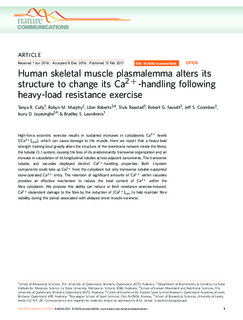| dc.contributor.author | Cully, Tanya R. | |
| dc.contributor.author | Murphy, Robyn M. | |
| dc.contributor.author | Roberts, Llion A. | |
| dc.contributor.author | Raastad, Truls | |
| dc.contributor.author | Fassett, Robert G. | |
| dc.contributor.author | Coombes, Jeff S. | |
| dc.contributor.author | Jayasinghe, Isuru D. | |
| dc.contributor.author | Launikonis, Bradley S. | |
| dc.date.accessioned | 2018-04-16T12:20:13Z | |
| dc.date.available | 2018-04-16T12:20:13Z | |
| dc.date.created | 2017-06-28T10:23:09Z | |
| dc.date.issued | 2017 | |
| dc.identifier.citation | Nature Communications. 2017, 8, 14266. | nb_NO |
| dc.identifier.issn | 2041-1723 | |
| dc.identifier.uri | http://hdl.handle.net/11250/2494259 | |
| dc.description | This work is licensed under a Creative Commons Attribution 4.0 International License. The images or other third party material in this article are included in the article’s Creative Commons license, unless indicated otherwise in the credit line; if the material is not included under the Creative Commons license, users will need to obtain permission from the license holder to reproduce the material. To view a copy of this license, visit http://creativecommons.org/licenses/by/4.0/ | nb_NO |
| dc.description.abstract | High-force eccentric exercise results in sustained increases in cytoplasmic Ca2+ levels ([Ca2+]cyto), which can cause damage to the muscle. Here we report that a heavy-load strength training bout greatly alters the structure of the membrane network inside the fibres, the tubular (t-) system, causing the loss of its predominantly transverse organization and an increase in vacuolation of its longitudinal tubules across adjacent sarcomeres. The transverse tubules and vacuoles displayed distinct Ca2+-handling properties. Both t-system components could take up Ca2+ from the cytoplasm but only transverse tubules supported store-operated Ca2+ entry. The retention of significant amounts of Ca2+ within vacuoles provides an effective mechanism to reduce the total content of Ca2+ within the fibre cytoplasm. We propose this ability can reduce or limit resistance exercise-induced, Ca2+-dependent damage to the fibre by the reduction of [Ca2+]cyto to help maintain fibre viability during the period associated with delayed onset muscle soreness. | nb_NO |
| dc.language.iso | eng | nb_NO |
| dc.subject | membrane biophysics | nb_NO |
| dc.subject | physiology | nb_NO |
| dc.title | Human skeletal muscle plasmalemma alters its structure to change its Ca2+-handling following heavy-load resistance exercise | nb_NO |
| dc.type | Journal article | nb_NO |
| dc.type | Peer reviewed | nb_NO |
| dc.description.version | publishedVersion | nb_NO |
| dc.rights.holder | © The Author(s) 2017 | nb_NO |
| dc.source.volume | 8 | nb_NO |
| dc.source.journal | Nature Communications | nb_NO |
| dc.identifier.doi | 10.1038/ncomms14266 | |
| dc.identifier.cristin | 1479408 | |
| dc.description.localcode | Seksjon for fysisk prestasjonsevne / Department of Physical Performance | nb_NO |
| cristin.unitcode | 150,31,0,0 | |
| cristin.unitname | Seksjon for fysisk prestasjonsevne | |
| cristin.ispublished | true | |
| cristin.fulltext | original | |
| cristin.qualitycode | 2 | |
